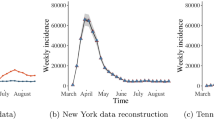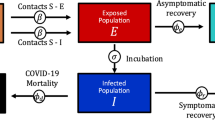Abstract
The spread of a disease caused by a virus can happen through human-to-human contact or from the environment. An estimation is crucial to make policy decisions and plan for the medical emergencies that may arise. Many mathematical models extend the standard SIR model to capture disease spread and estimate the infections, recoveries, and fatalities that may result from the disease. One major factor important in the forecasts using the models is the dynamic nature of the disease spread. Unless we can develop a way to guide this dynamic spread, estimating the parameters may not give accurate forecasts. To capture the transmission dynamics, we implement a time-dependent SEIRD model. In this data-driven model, we try to estimate parameters from the equations derived from the traditional SEIRD model. The main principle is to keep the model generic while making minimal assumptions. In this work, we have derived a data-driven model from SEIRD, where we attempt to forecast infected, recovered, and deceased rates of COVID-19 for the next 21 days. A method for estimating the dynamic change in the parameters of the model is the crucial contribution of this work. The model has been tested for India at the district level and the USA at the state level. The mean absolute percentage error (MAPE) obtained for predicting confirmed/deceased for day 7 is between 4–5%, by day 14 is about 8–10%,and 12–15% for day 21. A dashboard has been developed based on the proposed model showing the predictions for active, recovered, and deaths at the district level in India [1]. We believe that these forecasts can help the governments in planning for emergencies such as ICU requirements, PPEs, and hospitalizations during the spread of infectious diseases.
Access this chapter
Tax calculation will be finalised at checkout
Purchases are for personal use only
Similar content being viewed by others
References
Worldometer: https://www.worldometers.info/coronavirus/
Prakash, M.K., Kaushal, S., Bhattacharya, S., Chandran, A., Kumar, A., Ansumali, S.: A minimal and adaptive prediction strategy for critical resource planning in a pandemic. medRxiv preprint https://doi.org/10.1101/2020.04.08.20057414 (2020)
Jenness, S.M., Goodreau, S.M., Morris, M.: EpiModel: An R package for mathematical modeling of infectious disease over networks. J. Stat Softw. https://doi.org/10.18637/jss.v084.i08) (2018)
Kermack, W.O, McKendrick, A. G.: A contribution to the mathematical theory of epidemics Proc. R. Soc. Lond. A. 115, 700–721 (1927). http://doi.org/10.1098/rspa.1927.0118
Das, S.: Prediction of Covid-19 Disease Progression in India . arXiv:2004.03147 [q-bio.PE] (2020)
Hethcote, H.W.: The mathematics of infectious diseases. SIAM Rev. 42(4), 599–653 (2000)
Yang, C., Wang, J.: A mathematical model for the novel coronavirus epidemic in Wuhan, China. Math. Biosci. Engi. 17(3), 2708–2724 (2020)
Tang, B., Bragazzi, N.L., Li Q., et al.: An updated estimation of the risk of transmission of the novel coronavirus (2019-nCov). Infect. Dis. Model. 5, 248–255 (2020)
Yang, Z., Zeng, Z., Wang, K., et al.: Modified SEIR and AI Prediction of the Epidemics Trend of COVID-19 in China Under Public Health Interventions. J. Thorac Dis. 12(3), 165–174 (2020)
Pandey, G., Chaudhary, P., Gupta, R., Pal, S.: SEIR and Regression Model based COVID-19 Outbreak Predictions in India. (arXiv:2004.00958 [q-bio.PE]) (2020)
Malik, F.: What is Grid Search? https://medium.com/fintechexplained/what-is-grid-search-c01fe886ef0a
Brownlee, J.: How to Backtest Machine Learning Models for Time Series Forecasting. https://machinelearningmastery.com/backtest-machine-learning-models-time-series-forecasting/
Chen, Y.-C., Lu, P.-E., Chang, C.-S., Liu, T.-H.: A Time-dependent SIR Model for COVID-19 with Undetected Infected Persons. http://gibbs1.ee.nthu.edu.tw/A_TIME_DEPENDENT_SIR_MODEL_FOR_COVID_19.PDF (2020)
COVID19-India API https://api.covid19india.org/
https://docs.google.com/spreadsheets/d/1e75JdBHr7bg1RO0zCAKAjKHvrMc3xxdpVSJ3ZxsJ6Pw/edit?usp=sharing
https://docs.google.com/spreadsheets/d/15tobWHlVuhwS4jSCNdxT-rX27-7NROFb3Dc3bRBcEBg/edit?usp=sharing
Rapolu, T., Nutakki, B., Rani, T.S., Bhavani, S.D.: A Time-Dependent SEIRD Model for Forecasting the COVID-19 Transmission Dynamics. https://doi.org/10.1101/2020.05.29.20113571 (2020)
Acknowledgements
We would like to thank Dr. Bharat Sharma, Dakshas for initiating us into this study and Raakhal Rapolu, Bennett University for his inputs and useful discussions on this project.
Author information
Authors and Affiliations
Corresponding author
Editor information
Editors and Affiliations
Ethics declarations
Funding
No funding was received for any aspect of the submitted work.
Conflicts of interest/competing interests
The authors declare no competing interest.
Availability of data and material
The data used in this model is open-sourced and available at the link given at [16, 17].
Code availability
The code used in running this model is available at [15].
Rights and permissions
Copyright information
© 2022 The Author(s), under exclusive license to Springer Nature Singapore Pte Ltd.
About this paper
Cite this paper
Rapolu, T., Nutakki, B., Sobha Rani, T., Durga Bhavani, S. (2022). A Time-Dependent SEIRD Model for Forecasting the Transmission Dynamics in Infectious Diseases: COVID-19 a Case Study. In: Saraswat, M., Roy, S., Chowdhury, C., Gandomi, A.H. (eds) Proceedings of International Conference on Data Science and Applications. Lecture Notes in Networks and Systems, vol 287. Springer, Singapore. https://doi.org/10.1007/978-981-16-5348-3_33
Download citation
DOI: https://doi.org/10.1007/978-981-16-5348-3_33
Published:
Publisher Name: Springer, Singapore
Print ISBN: 978-981-16-5347-6
Online ISBN: 978-981-16-5348-3
eBook Packages: Intelligent Technologies and RoboticsIntelligent Technologies and Robotics (R0)




